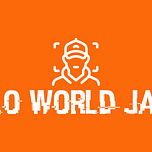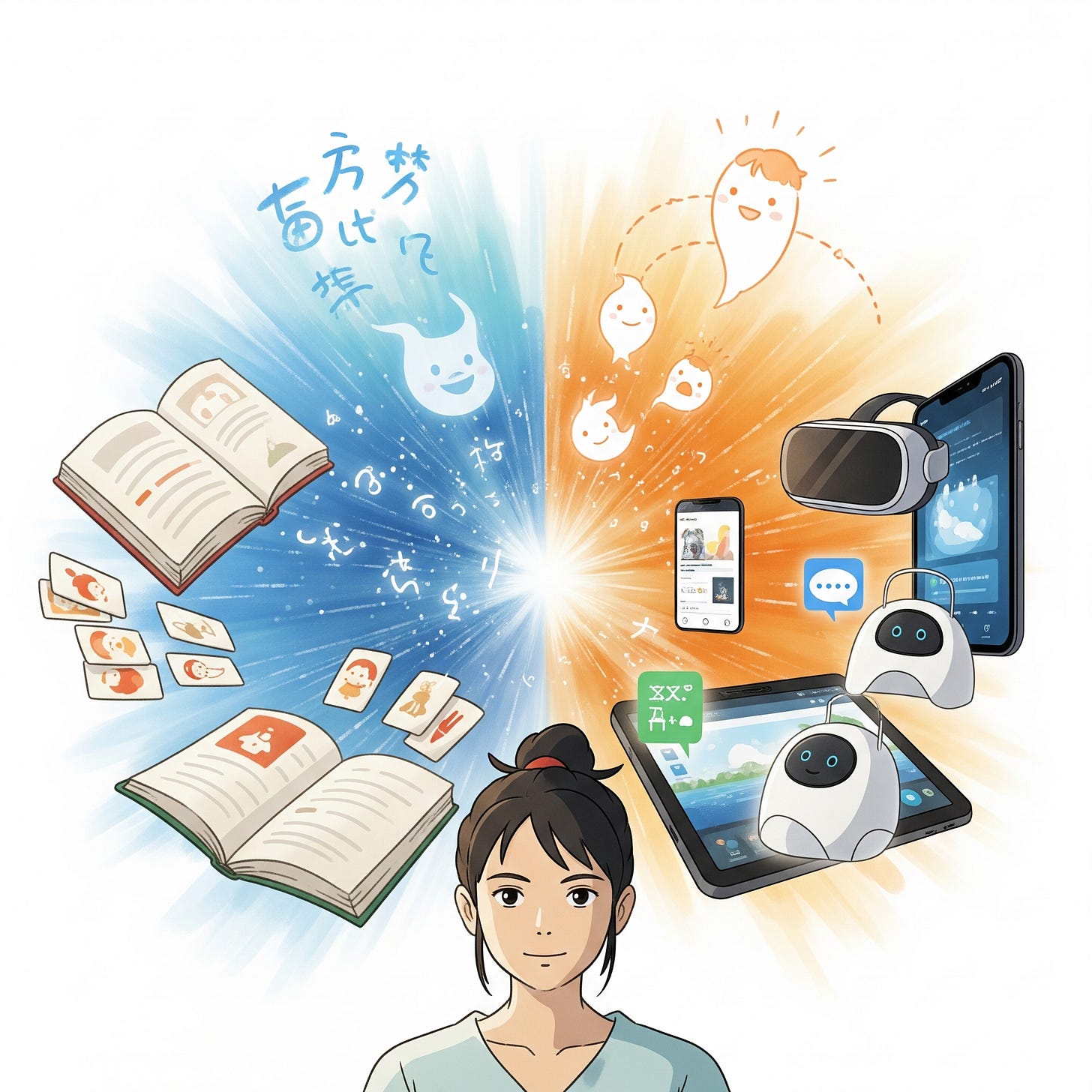Introduction
The study of the Japanese language presents a significant yet rewarding endeavor, characterized by its complex writing systems and unique grammatical framework. In recent years, language education has pivoted from traditional, grammar-focused teaching to methods informed by empirical research in Second Language Acquisition (SLA) and augmented by technology. This article provides an evidence-based guide to contemporary techniques for learning Japanese, aiming to empower learners to optimize their path to fluency.
While theoretical and empirical research in language acquisition has expanded, studies specifically targeting adult second-language (L2) learners of Japanese remain relatively scarce, particularly in English [1]. This highlights the need to synthesize existing SLA principles and apply them to the Japanese learning context. As global demand for bilingualism grows, clear, evidence-backed guidance for adult learners is increasingly vital [2].
The "modern" approach to learning Japanese transcends new technology, representing a paradigm shift toward learner autonomy and personalized learning paths. Facilitated by a deeper understanding of language acquisition, learners are moving from a one-size-fits-all model. They now construct individualized strategies, leveraging diverse resources based on their specific needs and core learning principles [2].
1. Foundational Pillars: Principles of Effective Language Acquisition
A successful journey in learning Japanese is built upon an understanding of the principles governing language acquisition. Decades of SLA research offer valuable insights, and recognizing the unique characteristics of adult learners is crucial for tailoring effective strategies.
1.1. Key Principles from Second Language Acquisition (SLA) Research
Several influential SLA theories provide a framework for modern learning methods. A cornerstone is Stephen Krashen's Input Hypothesis, which posits that language is acquired through "comprehensible input"—language that is slightly beyond a learner's current proficiency, or 'i+1' [4]. This theory prioritizes understanding messages over the conscious study of grammar or explicit error correction [6, 7].
Complementing this, Merrill Swain's Output Hypothesis argues that producing language (speaking and writing) is also critical. Output helps learners identify gaps in their knowledge, test linguistic hypotheses, and build fluency [4]. Receiving corrections on output proves beneficial at all learning stages [9]. Michael Long's Interaction Hypothesis further emphasizes that meaningful interaction, through the "negotiation of meaning" (e.g., asking for clarification), makes input more comprehensible and facilitates acquisition [4].
Lev Vygotsky's Sociocultural Theory (SCT) frames language learning as a social and cultural process, occurring through interaction within meaningful cultural activities [4]. Emotionally, Krashen's Affective Filter Hypothesis suggests that factors like anxiety and low motivation can hinder input processing, underscoring the need for a positive, low-anxiety environment [4]. Finally, Cognitive Theory views learners as active constructors of knowledge who use mental processes like memory and problem-solving, aligning with the use of explicit strategies like mnemonics and spaced repetition [4].
These dominant theories converge on a meaning-focused, communicative, and context-rich learning model, contrasting with older methods centered on rote memorization or drills [4]. For adult learners, who possess advanced metacognitive skills, an optimal approach combines environments rich in comprehensible input for subconscious acquisition with the simultaneous use of conscious, strategic learning techniques [2, 10].
1.2. The Adult Learner: Advantages and Considerations
Adults approach learning Japanese with mature cognitive abilities and a fully developed first language (L1), which can be leveraged to understand abstract grammar or use memory strategies [10]. However, achieving native-like pronunciation can be a challenge, often linked to the critical period hypothesis, and there is a risk of "fossilization," where certain errors become resistant to correction [10].
Self-Directed Learning (SDL) is a common mode for adults, with success depending on motivation, technology access, strategic practices, and metacognitive skills for planning and self-assessment [2]. Barriers such as inadequate digital literacy, economic constraints, or weak metacognitive skills can hinder SDL, sometimes leading to high dropout rates [2].
This reality reinforces the need for a blended approach where subconscious acquisition is supported by deliberate learning. Guidance for adults should not only recommend methods like comprehensible input but also equip them to be effective self-directed learners. Given the challenges with pronunciation, a comprehensive plan for adults should integrate dedicated phonetic practice from the early stages, rather than treating it as a secondary concern [10, 11, 12].
2. Building Your Linguistic Core: Mastering the Essentials
A robust foundation in Japanese requires a methodical approach to its writing systems, grammar, and phonology.
2.1. The Japanese Writing Systems: Kana and Kanji
Japanese utilizes three scripts: Hiragana, Katakana (together known as kana), and Kanji.
2.1.1. Efficiently Learning Hiragana and Katakana (The Kana)
The kana are phonetic syllabaries essential for reading and basic grammar [3, 14]. Modern learning methods prioritize efficiency. Creating memorable associations, or mnemonics, between a kana's shape and its sound is highly effective [17, 18].
A pragmatic "reading first" approach is increasingly recommended, focusing on recognizing kana before mastering handwriting. This allows learners to engage with beginner texts and type in Japanese much faster, which can be highly motivating [16]. Active recall through flashcards and reading exercises is crucial to solidify these associations [18]. Resources like Tofugu and the Dr. Moku app are known for their effective mnemonic-based methods [16, 18].
2.1.2. Conquering Kanji: SRS, Mnemonics, and Integrated Approaches
Kanji are logographic characters requiring a significant time investment, with approximately 2,136 characters needed for general literacy [15]. Spaced Repetition Systems (SRS) are a cornerstone of efficient Kanji memorization, optimizing retention by scheduling reviews at increasing intervals [20].
Popular SRS tools include WaniKani, which teaches radicals, Kanji, and vocabulary through a structured system of mnemonics and SRS, and Anki, a highly customizable flashcard program [3, 19]. Mnemonics, which create stories to link a Kanji's shape, meaning, and readings, are invaluable [19].
Learners can choose between a "recognition-first" approach like Heisig's Remembering the Kanji (RTK), which prioritizes meaning before readings, or a vocabulary-integrated approach that learns Kanji within useful words [3]. The latter is often considered more practical as it allows for earlier engagement with reading, which is fundamental for accessing comprehensible input [3, 7]. The choice of strategy should align with the learner's goal of interacting with authentic texts.
Table 1: Overview of Spaced Repetition Systems (SRS) for Japanese Learning
ToolCore Principle(s)Primary FocusKey FeaturesUser Experience Notes / Reported Pros & Cons
Anki
SRSKanji, Vocab, Grammar (Custom)Highly customizable decks, user-created content, cross-platform, free
Pros: Flexible, powerful, vast shared deck library.
Cons: Steep learning curve, self-grading can be an issue [19], quality of shared decks varies, requires self-discipline.
WaniKani
SRS, MnemonicsRadicals, Kanji, Vocab (Structured)Pre-set curriculum, curated mnemonics, strict review intervals, gamified levels
Pros: Structured path, effective mnemonics, teaches readings with vocab, good for discipline.
Cons: Subscription-based, less flexible, order of kanji may not suit all [19].
MochiKanji
SRSKanji, Vocab"Golden Time" review notifications, combines Kanji & vocab practice
Pros: Focus on optimal review timing, integrated learning.
Cons: Less widely discussed in provided materials compared to Anki/WaniKani [14].
BunPro
SRSGrammarFocus on JLPT grammar points, example sentences, customizable review paths
Pros: Specifically for grammar, contextual learning with sentences, SRS for rules.
Cons: Primarily grammar-focused, may need other tools for vocab/kanji [14].
2.2. Demystifying Japanese Grammar
Japanese grammar, with its Subject-Object-Verb (SOV) structure and particle system, requires a systematic approach.
2.2.1. Systematic Study: Textbooks and Structured Guides
A structured introduction via textbooks like Genki or online resources like Tae Kim's Guide is beneficial for beginners [3, 11, 14]. Understanding core principles like SOV word order, particle functions, and politeness levels is crucial [14]. While some CI proponents downplay explicit study, foundational grammar knowledge provides a valuable framework for understanding input, especially for adult learners [7, 9]. The key is to ensure grammar study supports, rather than supplants, extensive language exposure.
2.2.2. Reinforcement through SRS and Contextual Practice
Internalizing grammar requires reinforcement. SRS apps like BunPro help memorize grammar points in context [14]. Keeping a grammar journal to create original sentences serves as a bridge from passive knowledge to active use, aligning with the Output Hypothesis [3, 4, 11]. Ultimately, applying grammar through writing and speaking solidifies understanding and builds fluency [11].
2.3. Achieving Clear Pronunciation and Listening Skills
Clear pronunciation and strong listening comprehension are vital for communication.
2.3.1. Understanding Japanese Phonetics
Japanese has a relatively small inventory of sounds and a mora-timed rhythm, where each sound unit is given equal duration. This contrasts with English's stress-timed rhythm and is key to a natural accent [15]. The five pure vowels (A, I, U, E, O) and the phonetic nature of the kana scripts are foundational [15]. Sounds requiring specific attention include the Japanese 'r', which is a flap between an English 'r' and 'l', and the 'fu' (ふ) sound [15].
2.3.2. Common Pitfalls for English Speakers and How to Avoid Them
Interference from an L1 is the source of most pronunciation errors. Key points to address include:
Vowel Length: Distinguishing between short and long vowels (e.g., おばさん obasan [aunt] vs. おばあさん obaasan [grandmother]) is critical as it can change word meanings [24].
Loanwords (Gairaigo): English loanwords are adapted to Japanese phonology, often by adding a final vowel (e.g., "ham" becomes ハム, ha-mu). Learners should avoid using English pronunciation [24].
Stress and Intonation: Applying English stress patterns instead of Japanese's flatter, mora-timed rhythm results in an unnatural sound [24].
The Japanese 'R' Sound: This sound is a light tap of the tongue, not the retroflex English 'r' [24].
The Small 'tsu' (Sokuon - っ): This character indicates a doubling of the following consonant, creating a slight pause that must be observed [24].
Effective instruction should explicitly contrast English and Japanese phonology at these points [24, 25].
3. Harnessing Modern Methodologies and Technologies
Contemporary learning is enhanced by innovative methods and powerful digital tools that build on established SLA principles.
3.1. The Comprehensible Input (CI) Revolution
The CI approach, based on Krashen's Input Hypothesis, advocates for acquisition through understanding meaningful messages in a low-anxiety environment [5, 7]. By focusing on meaning, learners are thought to subconsciously acquire vocabulary and grammar, similar to first language acquisition [7].
A growing body of resources provides CI for Japanese learners. Comprehensible Japanese (CIJ) offers a large video library where teachers speak slowly and use visual aids to maximize understanding [7]. Other sources include YouTube channels (Japanese Immersion with Asami, Tokini Andy), graded readers (Satori Reader), simplified news (NHK News Web Easy), and dubbed children's shows [21, 23, 30, 33]. While some proponents advocate for a "pure" CI approach, many learners find that foundational skills like kana literacy make input more comprehensible from the start [7, 21]. A balanced strategy often combines CI with targeted study using tools like SRS [29].
Table 2: Key Comprehensible Input (CI) Resources for Japanese Learners
Resource TypeSpecific ExamplesTarget Level(s)Key Features for CICost (General)
Video Platform
Comprehensible Japanese (cijapanese.com) [7]Beginner to Advanced100% Japanese, slow/clear speech, visuals, repetition, transcriptsFreemium/SubscriptionVarious YouTube Channels (e.g., Japanese Immersion with Asami, Tokini Andy) [30]Varies by channelOften visuals, real-life contexts, some with subtitles/transcriptsMostly Free
Audio/Podcast
JapanesePod101 [14]Beginner to AdvancedDialogues, cultural notes, grammar explanations, transcripts (premium)Freemium/SubscriptionBite Size Japanese, Moshimoshi Yusuke, Sayuri Saying, Yuyu Nihongo (Podcasts/YT) [30]Intermediate (mostly)Native speaker talk, some with transcripts or on-screen textMostly Free
Graded Reader App
Satori Reader [21]Beginner to IntermediateGraded articles, human-read audio, detailed annotations, furiganaSubscriptionNews SiteNHK News Web Easy [33]IntermediateSimplified news articles, furigana, audio, vocabulary definitionsFree
Children's Media
Peppa Pig (Japanese dub), Pororo (Japanese dub) [30]BeginnerSimple language, visual context, repetitionVaries (e.g., YouTube)
3.2. Immersive Learning: Creating Your Japanese World
Immersion involves surrounding oneself with the target language to create consistent exposure [8]. Active immersion includes focused activities like reading Japanese books or watching anime with Japanese subtitles, while passive immersion involves having Japanese audio in the background [34]. Practical strategies include changing device languages, playing video games in Japanese, and following Japanese social media accounts [11, 34].
Effective immersion is a conscious, strategic effort to maximize meaningful engagement, not merely a function of being physically located in Japan [8, 35]. The key is consistency and choosing materials that are genuinely interesting and at a comprehensible level (around 80% understanding is a common benchmark) [3, 9].
3.3. The Rise of Digital Tutors and Tools
Technology offers a plethora of aids for language learning, from AI tutors to gamified apps.
3.3.1. AI-Powered Language Learning
Artificial Intelligence (AI) can offer personalized and adaptive learning experiences, with studies showing effectiveness in improving grammar, vocabulary, and other skills [36]. AI tutors and chatbots can increase engagement and practice time, leading to improved performance [37]. However, research often has limitations, and current AI may not replicate the nuanced, culturally rich interaction provided by human tutors [11, 37]. Thus, AI is best viewed as a powerful supplementary tool for targeted practice.
3.3.2. Effectiveness of Language Learning Apps
A vast array of apps exists, each with a different focus.
Rocket Japanese and Pimsleur are strong in audio-based conversational skills, while Rosetta Stone uses an image-based immersion method [13]. Lingopie uses TV shows for learning, and apps like Duolingo and Mondly use gamification for motivation [3, 13]. The "best" app is subjective; an effective strategy often involves a "mix-and-match" approach, combining several specialized resources to suit one's goals and learning style [3].
Table 3: Comparison of Popular Japanese Language Learning Apps/Platforms
App/Platform NamePrimary Method(s)Key FeaturesReported StrengthsIdeal Learner Profile
Rocket Japanese
Audio-Lingual, ComprehensiveInteractive audio, speech recognition, grammar/culture notesWell-rounded, mirrors real dialogue [13]Serious learners seeking a structured course
Pimsleur Japanese
Audio-LingualCore audio lessons, Voice Coach, driving modeStrong for listening/speaking [13]Auditory learners focused on spoken fluency
Rosetta Stone
Immersion (Dynamic Immersion)Image-based learning, TruAccent speech techImmersive, good for visual learners [13]Visual learners who prefer learning via context
Lingopie Japanese
Immersion (Video-based), CILearning via TV shows/movies, interactive subtitlesEngaging content, learning in context [3]Learners motivated by authentic media
Duolingo
Gamification, Repetitive ExercisesPoints, streaks, levels, vocabulary focusHighly motivating for beginners, good for vocabulary [11]Beginners, casual learners, those who enjoy gamification
WaniKani
SRS, MnemonicsStructured Kanji/vocab curriculum, mnemonicsEffective for systematic Kanji acquisition [19]Learners prioritizing structured Kanji learning
Comprehensible Japanese (CIJ)
CI (Video-based)100% Japanese videos, slow/clear speech, visualsNatural acquisition, focus on listening [7]Learners preferring acquisition through input
3.3.3. Gamification: Enhancing Motivation
Gamification integrates game elements (points, levels) to boost motivation and cognitive engagement [39]. It can improve working memory, focus, and retention while reducing anxiety [39, 40]. However, its motivational impact can wane, and poorly designed games may lead to superficial learning [40]. Long-term effectiveness depends on deeply integrating game mechanics with meaningful learning objectives that foster intrinsic motivation [40].
3.3.4. Virtual Reality (VR): Stepping into Japanese Conversations
VR technology offers a highly immersive approach by placing users in simulated Japanese-speaking environments like restaurants or shops [12]. Platforms like Dynamic Languages focus on developing communicative competence through interactive scenarios with speech recognition feedback. A key benefit is the reduction of speaking anxiety, allowing learners to build confidence in a controlled yet contextually rich setting, effectively bridging the gap between structured learning and real-world interaction [12].
4. Sustaining Momentum and Overcoming Hurdles
Learning Japanese is a long-term commitment where psychological resilience and strategic planning are as important as the methods used.
4.1. The Psychology of Language Learning
Intrinsic motivation—learning for personal interest—is critical for long-term success, especially in self-directed learning [2, 3]. Consistency is also paramount; regular, short study sessions are more effective than sporadic cramming. Building daily habits for review and immersion helps maintain progress when motivation fluctuates [3, 9]. Finally, setting clear, achievable goals, such as aiming for a specific JLPT level, provides direction and tangible milestones [42].
4.2. Breaking Through: Navigating the Intermediate Plateau
The "intermediate plateau" is a phase where progress seems to stagnate. Strategies to overcome this include varying learning methods, setting new goals, and shifting to more active language use [33, 42]. This involves advanced techniques like intensive reading (slowly analyzing a text) and extensive reading (reading for gist), as well as active listening to educational content and passive listening to native-level broadcasts to attune the ear to natural speech patterns [33].
4.3. The Power of Interaction
Interaction with other speakers is vital for acquisition [4]. Tutors can provide personalized feedback and cultural insights, while language exchange partners offer authentic communication practice [3, 11]. In-person opportunities exist in language exchange cafes and Meetup groups, especially in cities like Tokyo [43, 44]. Online, platforms like HelloTalk and Tandem connect learners globally [14, 43]. The quality of these interactions is key; learners should be proactive in structuring exchanges for mutual linguistic benefit.
4.4. Common Challenges for English Speakers
Due to significant linguistic differences, English speakers face specific hurdles:
Writing Systems: The three scripts require a systematic, long-term learning strategy [49].
Grammar: The SOV word order, the nuanced functions of particles, and the complex politeness system (keigo) require deliberate practice and contextual learning [14, 25]. The frequent omission of subjects also requires an adjustment to a high-context communication style [25].
Vocabulary and Culture: Homophones, loanwords with different pronunciations (gairaigo), and numerous counter words present challenges [24, 25]. Many of these are deeply tied to cultural concepts like indirectness and social hierarchy, meaning that cultural understanding is not a supplement but an integral part of linguistic competence [25].
5. Conclusion: Charting Your Path to Japanese Fluency
The path to Japanese fluency is a multifaceted journey best undertaken with a blend of modern methodologies and sustained, strategic effort. The contemporary learning paradigm is holistic and learner-centric, built on a foundation of mastering the writing systems and core grammar [3]. These foundational skills, however, are now seen as tools that enable deeper, meaning-focused engagement with the language.
The principles of SLA, especially the importance of Comprehensible Input (CI), have become central, promoting acquisition through immersion in understandable and interesting content [4, 7]. This is supported by powerful technologies like Spaced Repetition Systems (SRS) for efficient memorization, and AI, gamified apps, and VR for personalized, motivating practice [3, 12, 39].
Sustaining momentum depends on psychological factors like motivation and habit, as well as crucial interaction with native speakers [2, 4]. Ultimately, the most effective path is a personalized one. The modern learner acts as an informed "meta-learner," understanding the principles behind different methods and flexibly combining them into a synergistic, sustainable, and enjoyable system. This integrated approach, managed by the learner, defines the most effective and rewarding journey to proficiency in Japanese.
Deep dive into the full article here:
https://helloworldjapan.com/effective-and-modern-methods-for-learning-japanese/















Share this post